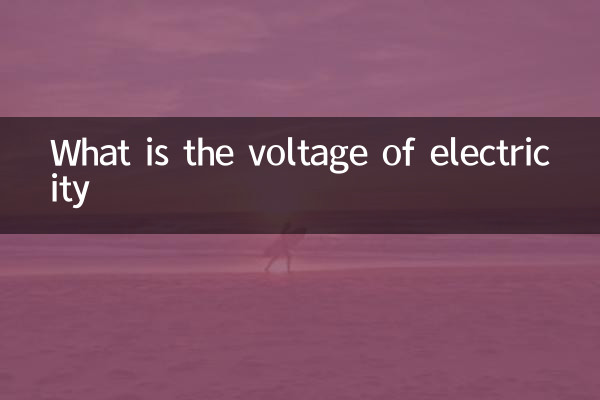What is the voltage of electricity
Voltage is a basic concept in electricity that represents the potential difference between two points in an electric field, usually measured in volts (V). The size of the voltage depends on the type of power supply and application scenario. In daily life, we are exposed to voltages ranging from a few volts to hundreds of volts. This article will combine the hot topics and hot content on the entire network in the past 10 days, introduce the relevant knowledge of voltage in detail, and present it in the form of structured data.
1. Common voltage types

Voltage can be divided into the following categories according to different application scenarios:
| voltage type | Typical value | Application scenarios |
|---|---|---|
| low pressure | 1.5V-24V | Batteries, small electronic equipment |
| Household voltage | 110V-240V | Household electricity and electrical appliances |
| high pressure | 1000V or more | Industrial electricity, power transmission |
2. Comparison of global household voltage standards
There are differences in household voltage standards in different countries and regions. The following is a comparison of household voltages in some countries and regions:
| Country/Region | Standard voltage | Frequency(Hz) |
|---|---|---|
| USA | 120V | 60 |
| China | 220V | 50 |
| Japan | 100V | 50/60 |
| European Union | 230V | 50 |
3. Recent hot topics: Electric vehicle voltage
In the past 10 days, electric vehicle battery voltage has become a hot topic. With the popularity of electric vehicles, the safety of battery voltage has attracted much attention. The following is a comparison of mainstream electric vehicle battery voltages:
| Electric vehicle brand | battery voltage | cruising range |
|---|---|---|
| Tesla Model 3 | 350V | 500km |
| BYD Han | 600V | 600km |
| NIO ES6 | 400V | 450km |
4. Safe use of voltage
Too high or too low voltage will pose a threat to equipment and personal safety. The following are precautions for safe use of voltage:
1.household appliances: Make sure the rated voltage of the appliance matches the local voltage standard to avoid damage caused by voltage incompatibility.
2.Charging equipment: Use original chargers to avoid voltage instability caused by inferior chargers.
3.Industrial electricity: High-voltage equipment needs to be operated by professionals and equipped with protective measures.
5. Future development trends of voltage technology
With the development of science and technology, voltage technology is also constantly innovating. Here are the recent hot trends:
1.High voltage fast charging: High-voltage fast charging technology (such as 800V system) for electric vehicles has become the focus of research and development, which can significantly shorten charging time.
2.smart grid: Improve grid stability and energy utilization efficiency by intelligently adjusting voltage.
3.micro power supply: Growing demand for low-voltage micro power supplies, such as batteries for wearable devices.
Conclusion
Voltage is an indispensable concept in electricity, with various values and application scenarios. From household appliances to industrial equipment, from traditional electricity to emerging technologies, voltage plays a role everywhere. Through the structured data and analysis of this article, I hope readers can have a clearer understanding of voltage-related knowledge and pay attention to future technological development.

check the details

check the details